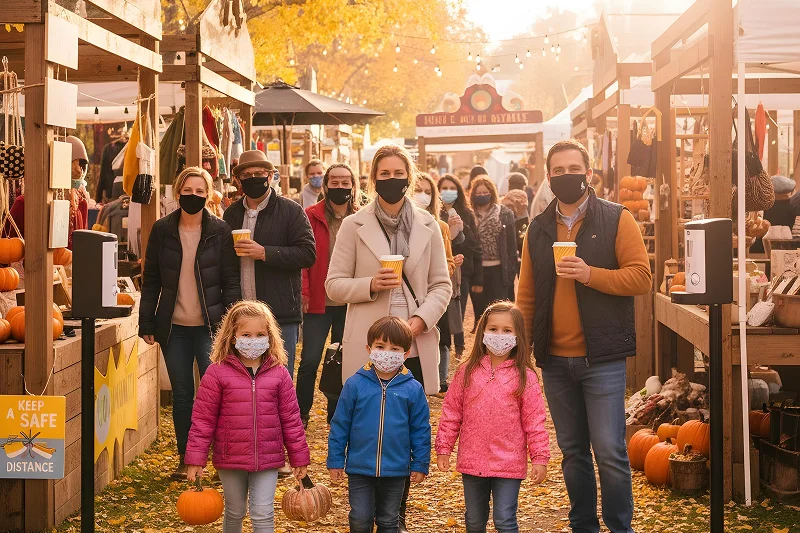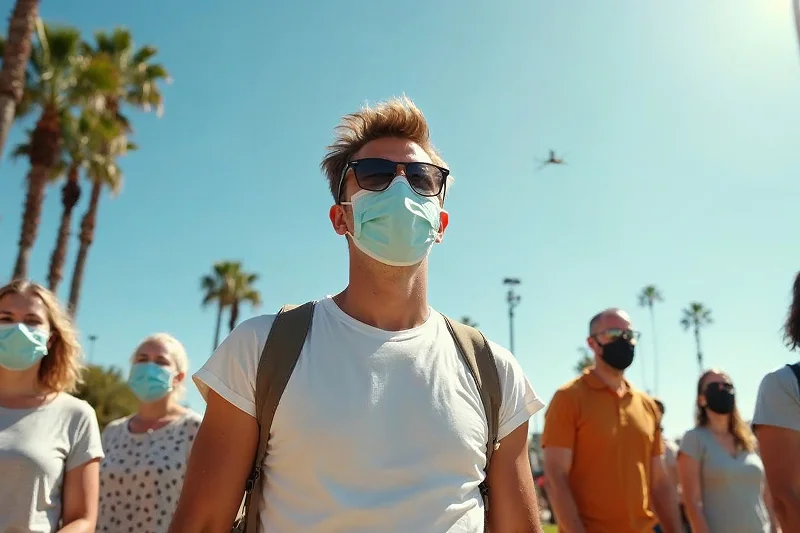Just a couple of weeks ago, our latest blog unpacked California’s dramatic summer COVID spike, detailing how cases more than doubled across the state and why residents were urged to mask up again.
Fast forward to mid-September, and the landscape is shifting according to the Los Angeles Times (Sept 16, 2025), cases have begun to plateau, offering cautious relief. But plateauing doesn’t mean the risk is gone, it simply signals a pause before another potential climb.
For Californians, this moment is both a breather and a warning. Health experts stress that now is the time to prepare for fall and winter when indoor gatherings, flu season, and cooler weather could trigger new waves. Whether you’re in Los Angeles, San Francisco, or South Bay communities like Torrance, the steps you take today will shape the months ahead. Local providers, including Torrance urgent care clinics, are already ramping up testing, boosters, and educational outreach to keep communities safe.
This blog distills the latest data, expert guidance, and practical strategies into an actionable fall COVID plan for Californians.
Table of Contents
Toggle1. Summer Spike Recap: What the Data Showed
According to the Los Angeles Times (Sept 3, 2025), California saw more than double cases between July and August.
CDC epidemic modeling (CDC Rt Estimates) reported an Rt value exceeding 1.2 in many counties, indicating active epidemic growth.
Our article released last week was on Stratus Summer: How California Is Facing the Latest COVID Wave
Emergency department (ED) visits for COVID climbed sharply, particularly in Los Angeles, Orange, and San Diego counties.
Unlike the 2020–2022 waves, hospitalizations didn’t overwhelm ICUs, thanks to widespread vaccination and immunity, but ICU admissions still rose 15% compared to early summer.
2. Recent Trends: Plateau or Turning Point?
By mid-September, case growth slowed, suggesting a plateau. LA Times (Sept 16, 2025) notes officials are cautiously optimistic.
Epidemiologists warn plateaus can precede rebounds, especially as cooler weather drives gatherings indoors.
Wastewater monitoring still shows elevated viral levels, a leading indicator that transmission remains widespread.
3. Lessons from the Summer Spike: What Worked and What Didn’t
This summer’s surge was a wake-up call, wasn’t it? Many of us thought COVID-19 was behind us, only to see cases climb again in July and August. Hospitals across Los Angeles County and other parts of California reported more than double the emergency visits compared to early summer. What did we learn?
First, masking in high-risk indoor areas really did make a difference for families and workplaces that adopted it early. Second, rapid at-home testing—though sometimes dismissed as “old news”—helped people catch infections before gatherings or trips. And third, even though vaccines don’t guarantee zero infections, boosted individuals were far less likely to face severe illness or hospitalization.
But here’s where we stumbled: many residents delayed testing until symptoms worsened, which allowed silent spread in workplaces and schools. Booster uptake also lagged in several counties. These gaps gave the virus room to run. As we step into fall, remembering these lessons can help us make smarter choices without falling back into fear-driven habits.
4. Monitoring Current Trends: Is the Plateau Real?
If you’ve been following the L.A. Times reports from September 8 and September 16, you already know the numbers are finally leveling off. But “leveling off” doesn’t mean “over.” Think of it like a wildfire that’s no longer spreading fast—there are still embers that can flare back up.
Public health dashboards show that the effective reproduction number (Rt) has dipped closer to 1.0, which is encouraging. Wastewater monitoring in several counties confirms a slowing of transmission. However, officials caution that cooler weather and holiday gatherings can reverse this progress.
This is the moment to stay informed, not to tune out. Bookmark your county health department’s COVID dashboard or the CDC’s tracker. Even a quick weekly check can keep you ahead of potential changes like updated mask advisories or booster recommendations. By staying engaged now, you’re less likely to be caught off-guard later.
5. Preparing for Fall: Vaccines, Boosters, and Respiratory Season
Fall in California means cooler evenings, back-to-school activities, and, unfortunately, tighter indoor spaces where respiratory viruses thrive. The good news? Updated COVID-19 boosters tailored for the latest variants are rolling out now. If it’s been more than six months since your last dose, this is the perfect time to schedule a booster.
Remember, it’s not just COVID on the radar. Flu and RSV are also making their seasonal rounds. The “tripledemic” risk is real, especially for older adults, young children, and people with chronic conditions. Many pharmacies and clinics now offer co-administration of flu and COVID vaccines, making it easier to get protected in a single visit.
Talk with your primary care provider or check reputable sources like the California Department of Public Health for eligibility updates. And if you’re unsure whether a booster makes sense for you, a quick telehealth consultation or a visit to Torrance Urgent Care can help you weigh your options based on your health history.
6. Testing and Treatment Access: What’s Available Now
Testing remains one of the simplest, most effective tools for protecting your loved ones. At-home rapid tests are widely available again; many community centers and libraries even provide them for free. But don’t overlook PCR testing if you’ve been exposed to or need confirmation for work or travel. PCR tests remain the gold standard for accuracy.
Treatment has also improved dramatically since the early days of the pandemic. Antiviral medications like Paxlovid can significantly reduce the risk of severe illness if started early—ideally within five days of symptom onset. The key is acting quickly: if you’re high-risk and test positive, contact your healthcare provider immediately or use telehealth services to discuss eligibility.
Community clinics and urgent care centers across California, including those in Torrance, can guide you through testing options and next steps if you’re unsure. By seeking care early, you not only protect yourself but also help prevent another surge.
7. Protecting Your Family and Workplace: Practical Tips
Let’s talk about real-life situations, family dinners, school events, or that office meeting where everyone shares snacks. Staying safe doesn’t have to mean canceling plans. Instead, think about layered protection:
Ventilation matters: Even cracking windows or using HEPA filters at home and in offices can reduce airborne particles.
Test before gatherings: Especially if you’re visiting grandparents or anyone at higher risk.
Stay home when sick: This one seems obvious, but it’s still one of the most overlooked steps.
Communicate openly: If you’re hosting, let guests know you’re being cautious and encourage the same courtesy.
Employers can help too: Simple measures like encouraging sick employees to stay home or offering hybrid workdays during spikes can reduce workplace outbreaks without drastic disruptions.
8. Coping with Long COVID and Post-Surge Recovery
Even as new cases decline, thousands of Californians are grappling with Long COVID, a condition that can linger for months or even years. If you’ve experienced brain fog, fatigue, or lingering shortness of breath weeks after recovery, you’re not alone. The CDC estimates that 10–15% of infected patients develop long-term symptoms.
California clinics have stepped up by opening specialized post-COVID care centers. These centers offer pulmonary rehabilitation, cognitive therapy, nutritional counseling, and even support groups where you can connect with others facing similar challenges. If symptoms persist beyond four weeks, seek an evaluation, early intervention can improve outcomes.
The emotional toll is also real. Anxiety and depression can accompany physical symptoms, making mental health support just as important as medical care. Don’t hesitate to reach out to community resources or mental health hotlines if you need someone to talk to. Recovery is a process, not a straight line.
For more guidance, check the CDC’s Long COVID resources or your county health department’s post-COVID programs.
9. Community and Policy Response in California
California has taken proactive steps throughout this surge. Counties like Los Angeles and Orange have issued advisories rather than mandates, emphasizing personal responsibility. The state has stockpiled N95 masks for distribution through local health offices, expanded telehealth options, and ensured that free boosters are accessible at community centers.
Partnerships with neighborhood organizations have also been key, bringing vaccines and testing directly to underserved areas. These efforts have helped close gaps that left some communities more vulnerable during previous waves. Staying engaged with these local initiatives, whether by volunteering, donating, or simply spreading accurate information, strengthens community resilience.
10. Staying Prepared: Practical Safety Tips for Residents
Preparedness doesn’t have to be complicated or stressful. Small habits can make a big difference:
Keep rapid tests at home. It saves time and stress if someone in your household develops symptoms.
Wear an N95 mask indoors in crowded spaces. Especially during cold and flu season.
Stay current with boosters. Mark your calendar as you would for dental checkups or oil changes.
Use telehealth for mild symptoms. It keeps clinics clear for urgent cases.
Improve ventilation. Fresh air is one of the cheapest and most effective tools we have.
Protect vulnerable loved ones. A quick test before visiting an elderly parent can prevent heartache.
Stay informed. Bookmark official dashboards so you’re never relying on rumors or outdated information.
These steps might seem small, but together they create a safety net that protects not only you but your entire community.
11. Comparing COVID with Flu and RSV in 2025
As we step into the colder months, remember: COVID isn’t the only respiratory virus circulating. The flu season looks to be a tough one, data from the Southern Hemisphere suggests a severe year ahead. RSV remains a significant threat to infants and older adults.
12.The key takeaway?
While flu and RSV can be serious, COVID still poses higher hospitalization risks for most adults. Staying on top of boosters and flu shots provides layered protection. If you’re in a higher-risk category or live with someone who is, consider discussing RSV vaccination options with your healthcare provider.
By understanding how these viruses overlap, you can make informed choices about gatherings, masking, and travel during the holidays. A little foresight now can prevent illness and disruptions later.
13.FAQ’s
Not yet. While cases have plateaued, wastewater data and Rt values suggest ongoing transmission. Experts advise continued precautions.
Yes, wait three months post-infection for the best immune response. Updated boosters are tailored for current variants.
Symptoms persisting 4+ weeks after infection, like fatigue or brain fog—warrant evaluation by your doctor or a Long COVID clinic.
Unlikely unless hospitalizations surge dramatically. Officials currently recommend voluntary masking indoors.
Check county health websites or local clinics. Many urgent care centers, including Torrance locations, continue to offer free or low-cost options.
COVID still causes more hospitalizations and deaths than flu or RSV, but all three can co-circulate and strain hospitals.
Stay up to date on boosters, maintain testing supplies, and improve indoor air quality, these measures collectively cut transmission risk significantly.



